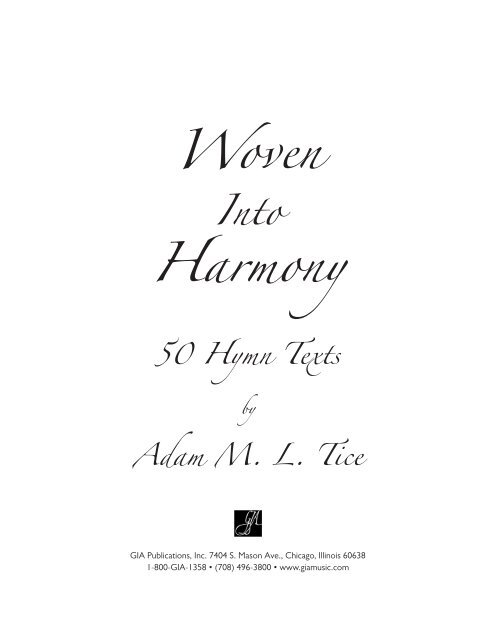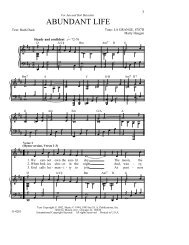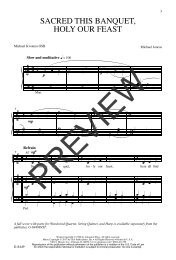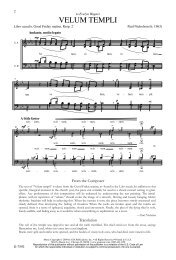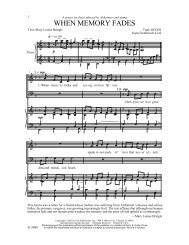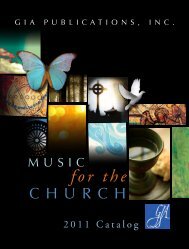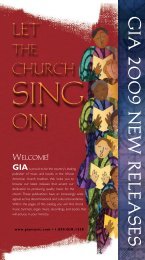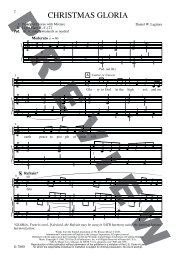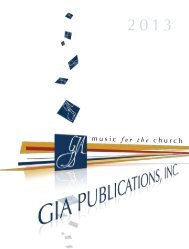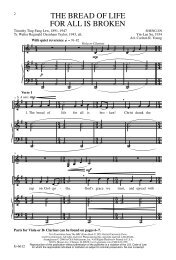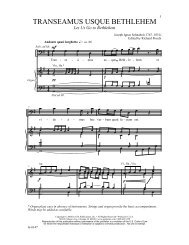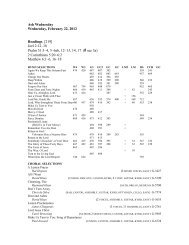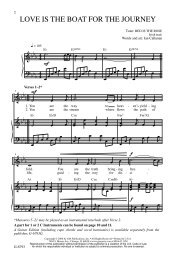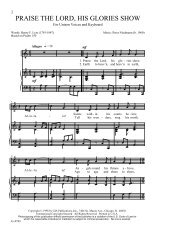G-7542 Tice Hymnary - GIA Publications
G-7542 Tice Hymnary - GIA Publications
G-7542 Tice Hymnary - GIA Publications
Create successful ePaper yourself
Turn your PDF publications into a flip-book with our unique Google optimized e-Paper software.
Woven<br />
Into<br />
Harmony<br />
50 Hymn Texts<br />
by<br />
Adam M. L. <strong>Tice</strong><br />
<strong>GIA</strong> <strong>Publications</strong>, Inc. 7404 S. Mason Ave., Chicago, Illinois 60638
Publisher’s Note<br />
The publication of this edition is intended to make available some of the collected hymn texts of Adam <strong>Tice</strong>. It is<br />
our hope that this volume will be useful to worship leaders and church musicians, and of special interest to hymnal<br />
editors and tune writers.<br />
Each text is first presented in poetic form, and then interlined with either an existing or newly composed tune.<br />
It is not our intent, however, that the singing of these texts be limited to the tunes with which they appear in this<br />
collection. Composers are invited to fashion new melodies to carry these words.<br />
<strong>GIA</strong> is dedicated to the work of this writer, and this publication represents a desire to introduce his work to the<br />
larger community. We are committed to simplifying the process by which individuals and congregations are able<br />
to use these hymns in their own work and worship. For non-commercial permission to reproduce the texts or tunes<br />
of these hymns, contact OneLicense.net or the individual copyright holders. <strong>GIA</strong> will make the hymns in this<br />
collection available through HymnPrint.net, an online service providing downloadable files for worship bulletins.<br />
Notice<br />
The unauthorized copying of the words or music of this edition, for any reason whatsoever, is a direct violation<br />
of the copyright law for which the person responsible, as well as the institution he or she represents, is subject to<br />
prosecution. This includes hand copying, photo copying, even the making of just one copy. To do so is to deprive<br />
the persons whose names appear in this edition, as well as the publisher and its employees, of just income.<br />
ISBN 13: 978-1-57999-762-5<br />
Woven into Harmony<br />
Cover design and illustration by Rosanna McFadden<br />
Copyright © 2009 by <strong>GIA</strong> <strong>Publications</strong>, Inc.<br />
7404 S. Mason Ave., Chicago, IL 60638 USA<br />
www.giamusic.com<br />
International Copyright Secured<br />
All Rights Reserved<br />
Printed in the USA.
Contents<br />
Foreword . . . . . . . . . . . . . . . . . . . . . . . . . . . . . . 4<br />
Biography.............................. 5<br />
Preface ................................ 6<br />
A Woman Poured Her Jar of Rich Perfume .... 8<br />
An Echo of the Voice of God.............. 10<br />
As the Birds of the Air ................... 12<br />
At the Pulpit, Font, and Table . . . . . . . . . . . . . 14<br />
Away in a Manger . . . . . . . . . . . . . . . . . . . . . . 16<br />
beyond . . . . . . . . . . . . . . . . . . . . . . . . . . . . . . . 18<br />
Breath of God, Breath of Peace ............ 20<br />
Christ Is for Losers...................... 23<br />
Christ, the Victorious .................... 26<br />
Come, Join in Mary’s Prophet-song......... 28<br />
Coming Together for Wine and for Bread .... 31<br />
Creation Is Not Built Upon . . . . . . . . . . . . . . . 34<br />
Earth Is Full of Wit and Wisdom ........... 36<br />
Every Eye Is Different ................... 38<br />
Fill Us with Your Breath . . . . . . . . . . . . . . . . . 40<br />
God Bestows on Every Sense . . . . . . . . . . . . . 42<br />
God, Bless the Doctor’s Art ............... 43<br />
God, Grant This Suffering Soul Release . . . . . 44<br />
God, in Our Praying..................... 46<br />
God of Music, Guide Our Song ............ 49<br />
God Says, “I Give My Earth to You”........ 50<br />
God, Your Knowing Eye Can See . . . . . . . . . . 52<br />
I AM the Living Water................... 54<br />
“I Have No Room”...................... 57<br />
In Floods of Chaos...................... 60<br />
In the Darkness of the Morning ............ 62<br />
Jesus Entered Egypt ..................... 64<br />
Jesus Promises Communion . . . . . . . . . . . . . . 66<br />
Jesus Said to Pray, “Our Father” . . . . . . . . . . . 68<br />
Jesus, Show Us How to Pray .............. 70<br />
On the Sabbath Day of Rest. .............. 72<br />
Open Your Eyes to the Image of God . . . . . . . 74<br />
“Peace Be with You!” . . . . . . . . . . . . . . . . . . . 76<br />
She Moves Where She Wishes. ............ 78<br />
The Church of Christ Cannot Be Bound . . . . . 80<br />
The Dazzle of Diamonds ................. 82<br />
The First One to Know . . . . . . . . . . . . . . . . . . 85<br />
The Spirit Is a Dove ..................... 88<br />
The Strong and Gentle Voice .............. 90<br />
The World at Day’s Dawn . . . . . . . . . . . . . . . . 92<br />
This Dreadful Cross ..................... 94<br />
We Dream of a Turning . . . . . . . . . . . . . . . . . . 96<br />
What Comfort Can Our Worship Bring ...... 98<br />
What New Endeavors Will We Dare . . . . . . . 101<br />
When Anyone Can Buy a Gun. ........... 104<br />
When Jesus Learned His Friend Had Died . . 106<br />
When Job the Great Was Brought to Tears . . 108<br />
When My Soul Is Sore and Troubled. ...... 110<br />
Who Follows Jesus?. ................... 112<br />
Who Is This Who Breaches Borders . . . . . . . 114<br />
Scriptural Index ....................... 116<br />
Liturgical and Topical Index . . . . . . . . . . . . . 120<br />
Index of Composers and Sources. ......... 123<br />
Metrical Index . . . . . . . . . . . . . . . . . . . . . . . . 124<br />
Tune Index . . . . . . . . . . . . . . . . . . . . . . . . . . . 125<br />
Title and First Line Index. ............... 126
4<br />
Foreword<br />
For the past several years I have had the pleasure of occasionally discovering among<br />
my incoming e-mails new hymn texts from Adam <strong>Tice</strong>. I always read them with much<br />
anticipation because I have learned to expect good things from him, and readers of the<br />
fifty hymns collected here will soon find out why.<br />
While a collection of hymns does not attempt to sustain a plot line like that of a mystery<br />
novel, I feel something akin to such a reviewer’s obligation not to give away too much<br />
in these introductory remarks. A significant part of the pleasure of discovering new<br />
hymns is finding how they give voice to a concern, an insight, a juxtaposition, a hope,<br />
a memory, a tension, or some other feature that has somehow been omitted in other<br />
hymns. Many such discoveries lie ahead in this volume.<br />
One way of appreciating Adam’s gifts as a hymnwriter is to keep in mind that he comes<br />
to the craft of text writing from his experience as a songleader in a tradition that primarily<br />
sings unaccompanied and in parts. Sensitivity to the pacing and pitching of singers<br />
carries over to a keen sense of the sonic aspects of his texts, especially in alliteration,<br />
assonance, and rhyme. Because these devices are used gracefully and unobtrusively,<br />
they add conviction and assurance to the texts rather than interrupting the flow of ideas.<br />
Similarly, to be an effective songleader, one needs a clear awareness of one’s own<br />
voice, and Adam has developed a comparable consciousness of the language that comes<br />
naturally to him. On more than one occasion when he has sent me a first draft of a new<br />
text, he has declined to use my hints for alternative words or phrases when they were not<br />
“something I would say.” But then he would recast the line or stanza in his own idiom<br />
and produce something more coherent than my piecemeal suggestion.<br />
There are numerous words and phrases in these hymns that definitely move beyond<br />
traditional hymnic vocabulary, but they are not inserted irresponsibly or for sheer<br />
shock value. On the contrary, they often evoke a response such as “Why have I never<br />
seen this word in a hymn before?” Admittedly, there are a few instances—such as<br />
a text involving both “gecko” and “sea slug”—that are intentionally lighthearted in<br />
the expansion of hymnic diction, but there are others that are breathtaking in their<br />
unflinching immediacy: “Christ is for losers,” “When anyone can buy a gun,” “we slash<br />
and burn and pave.” Yet whether amusing or challenging or meditative or narrative or<br />
anything else, the very variety and range of the language ultimately contributes to a<br />
sense that these hymns merit careful attention.<br />
Comparable to this breadth of vocabulary is the diversity of the metrical forms in<br />
which these hymns are cast. The fifty hymns in this collection employ no less than<br />
thirty-five distinct meters, several of which are not found in most hymnals. Yet the<br />
technical challenge never becomes the central concern of the text. Instead, it operates<br />
as a means of enhancing the intent of the hymn and gives life to lines that could well<br />
have become pedestrian in more familiar meters.<br />
Because some of the tunes selected to carry these texts are well known from other<br />
hymns, the associations with previous texts often intensify the experience of singing<br />
the new pairings that appear in this volume. The incarnational connotations of CRANHAM,
5<br />
for example, add poignancy to a text about enlarging our sense of the range of human<br />
differences. In other cases, the incorporation of tunes usually regarded as secular serves<br />
as a reminder that the whole of life is within God’s keeping and deserves attention in<br />
our sung prayer. Operating in a slightly different way, the retrieval of unfamiliar tunes,<br />
such as the sturdy, Welsh LLEDROD, gives depth and energy to new words. And the<br />
constant unfolding and growing of congregational song is evident in the tunes by living<br />
composers that either inspired or were inspired by the texts appearing here.<br />
As I hope these introductory comments will indicate, Adam <strong>Tice</strong> has brought together<br />
here a remarkable first collection of hymns deserving attention and use. They leave one<br />
both grateful and eager for more.<br />
—Carl P. Daw, Jr.<br />
Executive Director<br />
The Hymn Society in the United States and Canada<br />
Biographical Sketch<br />
Adam M. L. <strong>Tice</strong> was born on October 11, 1979, in the mountains of western Pennsylvania,<br />
and grew up in Alabama, Oregon, and Indiana. After graduating from high school in<br />
Elkhart, Indiana, Adam went to nearby Goshen College, a Mennonite liberal arts school.<br />
He majored in music with an emphasis on composition and completed a minor in Bible<br />
and religion, graduating in 2002. He began working as a church musician and choir<br />
director while still in college.<br />
Adam took his first course at the Associated Mennonite Biblical Seminary in the fall of<br />
2003, which led to the writing of his initial hymn text. Four years later (including a yearlong<br />
interlude as a full time marionette puppeteer), Adam graduated with a Master of the<br />
Arts in Christian Formation with an emphasis on worship. He completed a thesis on the<br />
life of Jesus as presented in Mennonite hymnals of the twentieth century. The Conrad<br />
Grebel Review published his research into ways that hymnody shaped the Mennonite<br />
practices of communion.<br />
He has led singing at numerous Mennonite and ecumenical events, including the 2008<br />
Hymn Sing for Peace on the steps of the United States Capitol reflecting pool.<br />
Adam was the winner of the tenth annual Macalester Plymouth United Church (St.<br />
Paul, Minnesota) hymn competition. More Voices, a hymn supplement for the United<br />
Church of Canada, was the first major collection to include one of his texts (“Breath of<br />
God, Breath of Peace”). Adam is a member of the Executive Committee of The Hymn<br />
Society in the United States and Canada.<br />
In November of 2007, Adam and his wife María moved to the Washington, DC, suburbs,<br />
where Adam was installed as Associate Pastor of Hyattsville Mennonite Church in<br />
Hyattsville, Maryland.
6<br />
Preface<br />
There is something disconcerting about writing this preface. As a student in seminary<br />
and as a beginning hymn writer, I have read paragraphs like these in order to glean<br />
wisdom about process and inspiration. The insecure part of me would suggest that the<br />
reader stop here and pick up a collection by a more seasoned writer. Read their forewords<br />
and find words of wisdom. Learn from Daw, Dufner, Bringle, Bell, Troeger, and Kaan,<br />
as I did. They will tell you how a hymn is written. Their prefaces introduce this work as<br />
well because their craft informed and inspired mine. But I will set aside my insecurity<br />
and tell my story. After all, each of the writers whom I admire once put together a first<br />
collection and wrote a first preface.<br />
It seems that every hymn writer has a moment of revelation, where for some reason<br />
or another they fit words together in this form for the first time. My epiphany came<br />
as an assignment in my first seminary course, “Congregational Song: Practices Past<br />
and Present.” Professor Rebecca Slough asked us to pick a favorite psalm and write a<br />
metrical version. We were to spend a maximum of thirty minutes on our text, lest we<br />
found it so challenging that it absorb an inordinate amount of time. My experience was<br />
surprisingly satisfying. The components of meter and rhyme provided a framework<br />
for poetic expressions of spirituality. Refining sentences and images into short poetic<br />
lines and stanzas becomes a sort of theological crossword puzzle. For most people, that<br />
combination of elements is horribly constraining. But for hymn writers the combination<br />
is strangely liberating. I tried my hand at several more texts, retelling the stories of<br />
Jesus as hymns. One of those early efforts, “When Jesus Learned His Friend Had<br />
Died,” appears in this collection.<br />
As Prof. Slough describes it, a floodgate was opened. I found my voice in the intricacies<br />
of the hymn form. I wrote at a fierce pace and within a year had produced some thirtysix<br />
hymns. Trained as a musician and immersed in the Mennonite singing tradition, I<br />
already saw my vocation as enabling the voice of congregations. Now I found myself<br />
giving words to those voices. The Associated Mennonite Biblical Seminary (Elkhart,<br />
Indiana) and Bethel Missionary Church (Goshen, Indiana) were willing proving grounds<br />
for the new hymns. Many of the texts I wrote were for specific worship services at<br />
those two communities, while others were responses to lectures or sermons.<br />
Finding the right word, the appropriate register of language, and just the right rhythm<br />
for a particular theme inspires me to test and refine my spirituality and theology. A<br />
rhyming dictionary will suggest a connection that I might not find in a theological<br />
textbook. A melodic arch will require me to identify the core of the idea I am processing.<br />
The constraints of the form actually free me to discover subtle nuances that I would<br />
miss in writing a sermon on the same topic.<br />
In the summer of 2004, less than a year after writing my first text, I experienced my<br />
first conference of The Hymn Society in the United States and Canada. I attended as<br />
a Lovelace Scholar and was star-struck from the start. I began meeting people whose<br />
hymns I had sung, studied, and loved, and found these luminaries to be remarkably<br />
down to earth, friendly, and generous. Since that time, many Hymn Society members
7<br />
have provided helpful critique and advice. Executive Director Carl Daw, who<br />
was already my favorite living hymn writer, deserves particular mention for his<br />
invaluable feedback.<br />
During that first conference I was paired with a roommate from Illinois named Chris<br />
Ángel. I gave him copies of my work the first day, and he began composing tunes for<br />
them by the second day. The parish he served, St. Patrick’s Catholic Church in Urbana,<br />
was the first congregation to sing a number of the texts by this Mennonite writer. One<br />
of my great joys in the publication of this collection is the inclusion of five of Chris’<br />
tunes. These are his first published compositions.<br />
Thanks to my Mennonite background, I am partial to tunes that can be sung a cappella<br />
and in parts; however, I enjoy and appreciate a wide variety of music, from chant, to<br />
folk, to rock. While I believe that the tunes provided in this collection will prove useful,<br />
they should not be considered the final word. Church musicians and editors should feel<br />
free to experiment with different pairings according to the needs of their communities. I<br />
especially hope that this publication will inspire the work of additional composers.<br />
Further pieces of this story will emerge as part of the commentary on individual<br />
hymns throughout the collection. I have been amazed and humbled that my words<br />
have served their purpose in communities of faith across the United States and Canada.<br />
I began writing in an attempt to fill a perceived void in Mennonite hymnals. We have<br />
traditionally sung very few hymns by Mennonite writers, and as a result we are shaped<br />
primarily by borrowed theology. I wanted to give voice to the unique contributions of<br />
our theology and to offer those gifts to the wider church. I hope that these hymns can<br />
express our shared longing for peace and justice, reconciliation, and the unfolding of<br />
the new creation.<br />
I acknowledge and thank:<br />
—the teachers who have shaped me musically and in other ways: Carol<br />
Nelson, Dennis Phipps, Doyle Preheim, Lee Dengler, Mary K. Oyer,<br />
and Rebecca Slough;<br />
—the innumerable Hymn Society friends and mentors who have<br />
encouraged me;<br />
—the people at <strong>GIA</strong> <strong>Publications</strong>, especially Randall Sensmeier, who<br />
developed this project with an expert editorial touch and graciousness;<br />
—Rosanna McFadden for providing the tree image for the cover of<br />
this collection;<br />
—Chris Ángel, Randall Sensmeier, Sally Ann Morris, and Ronald<br />
Krisman for tunes written specifically for this collection, as well as the<br />
numerous other composers who have granted permission for their works<br />
to appear here;<br />
—the communities of faith that have nurtured my writing and tested<br />
the results: Bethel Missionary Church, Associated Mennonite Biblical<br />
Seminary, and Hyattsville Mennonite Church;<br />
—my parents, Ezra and Joan <strong>Tice</strong>;<br />
—my most honest critic and beloved companion in life, María Celesta<br />
Longoria <strong>Tice</strong>.<br />
—Adam M. L. <strong>Tice</strong>


